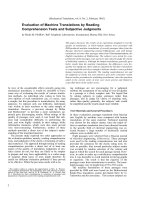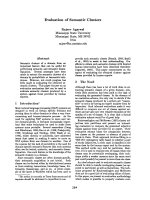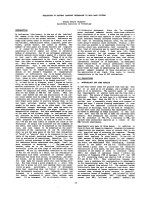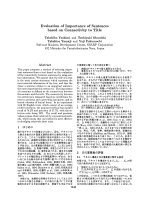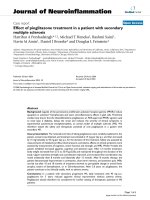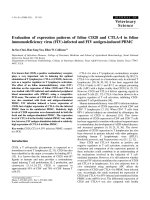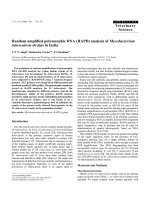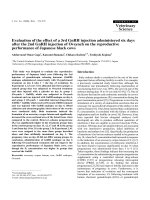Báo cáo khoa học: " Evaluation of furosemide regimens in neonates treated with extracorporeal membrane oxygenation" doc
Bạn đang xem bản rút gọn của tài liệu. Xem và tải ngay bản đầy đủ của tài liệu tại đây (185.01 KB, 8 trang )
Open Access
Available online />Page 1 of 8
(page number not for citation purposes)
Vol 10 No 6
Research
Evaluation of furosemide regimens in neonates treated with
extracorporeal membrane oxygenation
MariaMJvan der Vorst
1
, Enno Wildschut
2
, Robbert J Houmes
2
, Saskia J Gischler
2
, Joana E Kist-
van Holthe
3
, Jacobus Burggraaf
4
, Albert J van der Heijden
5
and Dick Tibboel
2
1
Department of Paediatrics, University of Kuwait, P.O. Box 24923, Safat 13110, Kuwait
2
Department of Paediatric Surgery, Erasmus MC, Sophia Children's Hospital, Dr Molewaterplein 60, 3000 CB Rotterdam, The Netherlands
3
Department of Paediatrics, Leiden University Medical Centre, Albinusdreef 2, 2300 RC Leiden, The Netherlands
4
Centre for Human Drug Research, Zernikedreef 10, 2333 CL Leiden, The Netherlands
5
Department of Paediatrics, Erasmus MC, Sophia Children's Hospital, Dr Molewaterplein 60, 3000 CB Rotterdam, The Netherlands
Corresponding author: Dick Tibboel,
Received: 25 Aug 2006 Revisions requested: 21 Sep 2006 Revisions received: 15 Nov 2006 Accepted: 1 Dec 2006 Published: 1 Dec 2006
Critical Care 2006, 10:R168 (doi:10.1186/cc5115)
This article is online at: />© 2006 van der Vorst et al.; licensee BioMed Central Ltd.
This is an open access article distributed under the terms of the Creative Commons Attribution License ( />),
which permits unrestricted use, distribution, and reproduction in any medium, provided the original work is properly cited.
Abstract
Introduction Loop diuretics are the most frequently used
diuretics in patients treated with extracorporeal membrane
oxygenation (ECMO). In patients after cardiopulmonary bypass
(CPB) surgery, the use of continuous furosemide infusion is
increasingly documented. Because ECMO and CPB are
'comparable' procedures, continuous furosemide infusion is
used in newborns on ECMO. We report on the use of
continuous intravenous furosemide in neonates treated with
ECMO.
Methods This was a retrospective observational study in
neonates treated with continuous intravenous furosemide
during ECMO.
Results Thirty-one patients were included in the study. A
median of 25 (9–149) hours after the start of ECMO,
continuous furosemide therapy was started at a median rate of
0.08 (0.02–0.17) mg/kg per hour. The continuous furosemide
dose was not changed in the individual patient. Seven patients
received a furosemide bolus prior to, and five patients received
additional loop diuretics during, the continuous infusion. Urine
production before continuous furosemide therapy was not
significantly different between patients who received a
furosemide bolus prior to the infusion and those who did not
receive this bolus (P = 0.2879). Although a positive effect of the
'loading' bolus was observed in urine output in the first 24 hours,
there was no statistically significant difference in urine output (P
= 0.0961) or in time (P = 0.1976) to reach a urine output of 6
ml/kg per hour between patients. After 24 hours, urine
production remained a median of 6.2 ml/kg per hour irrespective
of furosemide boluses. The forced diuresis was well tolerated as
illustrated by stable haemodynamic parameters and a decrease
in ECMO flow and vasopressor score over the observation
period.
Conclusion This is the first report on continuous intravenous
furosemide therapy in newborns treated with ECMO. The
furosemide regimens used in this study varied widely in
continuous and intermittent doses. However, all regimens
achieved adequate urine output. An advantage of continuous,
over intermittent, intravenous furosemide could not be
documented. Furosemide dosing regimens should be
developed for neonates treated with ECMO. In addition,
therapeutic drug-monitoring studies are required to prevent
furosemide toxicity because so far no data are available on
serum furosemide levels in neonates treated with ECMO.
Introduction
Extracorporeal membrane oxygenation (ECMO) is performed
in newborns for a variety of diagnoses, including meconium
aspiration syndrome (MAS), congenital diaphragmatic hernia
(CDH), persistent pulmonary hypertension of the newborn
(PPHN), and sepsis/pneumonia [1]. The ECMO circuit, like
the cardiopulmonary bypass (CPB) circuit, triggers an impor-
tant inflammatory reaction and is clinically associated with the
so-called capillary leakage syndrome, resulting in intravascular
hypovolaemia and renal hypoperfusion [2]. Hence, the ECMO
CAVH = continuous veno-arterial haemofiltration; CDH = congenital diaphragmatic hernia; CPB = cardiopulmonary bypass; ECMO = extracorporeal
membrane oxygenation; HR = heart rate; ICU = intensive care unit; IV = intravenous; MAP = mean arterial pressure; MAS = meconium aspiration
syndrome; PK = pharmacokinetics; PK/PD = pharmacokinetic/pharmacodynamic; PPHN = persistent pulmonary hypertension of the newborn; VA =
venoarterial.
Critical Care Vol 10 No 6 van der Vorst et al.
Page 2 of 8
(page number not for citation purposes)
patient usually becomes increasingly oedematous in the initial
phase and diuretics are often used to enhance the diuresis to
mobilise the fluid excess. Loop diuretics, generally given as an
intravenous (IV) bolus, are the most frequently used diuretics
in patients treated with ECMO [3]. Since the observation that
continuous IV furosemide might be superior (especially in
haemodynamically unstable patients) to intermittent adminis-
tration in infants after cardiac surgery, the use of continuous
furosemide infusion has been increasingly documented in
patients after CPB surgery [4-8]. Although there are no data
available evaluating the use of continuous IV furosemide in
newborns during venoarterial (VA) ECMO, continuous furo-
semide infusion is used increasingly in our unit in newborns
treated with ECMO because ECMO and CPB are 'compara-
ble' procedures. Although the dosing schedule is largely
empirical in this group of patients with varying renal function
and altered pharmacokinetics (PK), the current practice is to
start with a low furosemide infusion rate (0.05–0.1 mg/kg per
hour) [3,9]. We retrospectively studied the use of continuous
IV furosemide in neonates treated with VA ECMO over a two
year period. In addition, neonates who did not receive contin-
uous IV furosemide during VA ECMO were evaluated.
Materials and methods
The study was performed at the paediatric surgical intensive
care unit (ICU) of the Sophia Children's Hospital of Erasmus
Medical Centre in Rotterdam, The Netherlands. This ICU
serves as one of two designated ECMO centres in The Neth-
erlands. The medical records of all neonates, who received
ECMO treatment between October 2002 and October 2004,
were screened for the use of furosemide, continuous and/or
intermittent IV, during ECMO treatment and consequently
studied by means of chart review in combination with data
available in the electronic patient data management system.
Demographic and clinical data recorded included gestational
and postpartum age, gender, weight, diagnosis, ECMO flow
and duration of ECMO treatment, time (after starting ECMO)
continuous furosemide infusion was started, dose and dura-
tion of continuous IV furosemide, additional loop diuretics, ino-
tropic support, and fluid intake. The following variables were
measured before and at regular time intervals during the study
for a maximum of 72 hours: urine output, heart rate (HR), mean
arterial blood pressure, and serum albumin, creatinine, and
urea levels.
Continuous IV furosemide was started at the time the patient
was cardiovascularly stable. The patient was considered car-
diovascularly stable if there was no need for ongoing fluid
resuscitation and/or increase in inotropic support. The amount
of inotropic support was measured by the vasopressor score
[10,11]. During continuous IV furosemide therapy, serum elec-
trolyte levels (sodium, potassium, calcium, and magnesium)
were closely monitored and supplements were given if
necessary.
Statistical analysis
All data are presented as median (range) unless indicated oth-
erwise. Wilcoxon two-sample tests were used for comparison
between the different furosemide regimens.
Results
General
Forty-six patients in whom VA ECMO was performed were eli-
gible for the study. Ten patients were excluded from the study
because they did not receive continuous IV furosemide during
ECMO. Thirty-six patients were enrolled in the study. Five
patients were excluded from analysis because they were
treated with continuous veno-arterial haemofiltration (CAVH).
Three patients were treated with CAVH because of acute
renal failure (median creatinine 90 μmol/l and urea 22.7 mmol/
l) and two patients were treated from the start of ECMO with
CAVH (trial). Thirty-one patients were analysed (Figure 1). The
study population consisted of 12 female and 19 male patients.
Median gestational age was 40 (35–43) weeks. On admis-
sion, median postpartum age was 1 (0–16) days and median
weight was 3.5 (2.3–5.2) kg. ECMO was performed for MAS
in 10 patients, for CDH in 13 patients, for sepsis/pneumonia
in five patients, for PPHN in two patients, and for cardiomyop-
athy in one patient. ECMO was started a median of 4 (0–46)
hours after admission. All patients were weaned from ECMO
after a median of 127 (44–339) hours. The median stay in the
ICU was 11 (3–186) days. Due to recurrent and therapy-
resistant pulmonary hypertension, five patients with CDH died
before discharge from the ICU.
Furosemide regimen
Prior to the start of continuous IV furosemide, seven patients
received an IV furosemide bolus (dose 1 [0.4–2.4] mg/kg).
Continuous IV furosemide therapy was started a median of 25
(9–149) hours after the start of ECMO at a median rate of
0.08 (0.02–0.17) mg/kg per hour. The continuous furosemide
therapy in patients with CDH was started after a median of 33
(11–149) hours. The continuous furosemide dose in the
patients who received a bolus prior to the infusion was 0.08
(0.04–0.13) mg/kg per hour; in the patients who did not
receive a bolus, the dose was 0.08 (0.02–0.17) mg/kg per
hour. The furosemide dose was not changed in the individual
patient during the study period. The administered continuous
IV furosemide dose over the span of 24 hours was a median
of 1.92 (0.48–4.08) mg/kg.
During the study period, five patients received additional loop
diuretics: four patients received a total median furosemide
dose of 7 (5.6–10.8) mg/kg, and one received a total bumeta-
nide dose of 0.1 mg/kg. The total administered continuous and
intermittent IV furosemide doses on the first, second, and third
days of the study were 1.92 (0.48–6.6), 1.92 (0.96–6.6), and
2.0 (0.5–6.6) mg/kg per 24 hours, respectively. The furosem-
ide regimen is depicted in Table 1.
Available online />Page 3 of 8
(page number not for citation purposes)
In 10 patients, continuous furosemide infusion was discontin-
ued a median of 2 (0–144) hours before decannulation, and in
21 patients it was discontinued a median of 25 (4–623) hours
after decannulation. The duration of the continuous furosem-
ide infusion during ECMO was a median of 98 (21–294)
hours, which is in accordance with a median of 80% (29%–
95%) of the ECMO time.
Furosemide effects
In the patients (n = 7) who received a furosemide bolus prior
to the continuous infusion, median urine production before the
start of continuous infusion was 2.2 ml/kg per hour; in the
patients (n = 24) who did not receive this furosemide bolus, it
was 2.4 ml/kg per hour (P = 0.2879). Median urine production
increased to 3.6, 5.7, and 6.4 ml/kg per hour, respectively,
after 8, 16, and 24 hours of furosemide infusion in the patients
(n = 7) who received a furosemide bolus prior to the continu-
ous infusion; in the patients (n = 24) who did not receive a
furosemide bolus, urine production values were 2.0, 4.3, and
6.3 ml/kg per hour, respectively (P = 0.0961). The time that
urine production of 6 ml/kg per hour was reached in the
patients with and without a bolus prior to the continuous infu-
sion was not significantly different (P = 0.1976). Median urine
production remained 6.2 ml/kg per hour after 24 hours of con-
tinuous furosemide infusion in all patients irrespective of a
bolus prior to the continuous furosemide infusion. Urine pro-
duction is shown in Figure 2.
Fluid balances, calculated over eight hour intervals, were a
median of +79.4 ml before the start of continuous furosemide
infusion in the patients who received a furosemide bolus prior
and +98.0 ml in the patients who did not receive this bolus.
Median fluid balances in the patients who received a furosem-
ide bolus prior were +76.9, -21, and -10.5 ml, respectively,
after 8, 16, and 24 hours of continuous furosemide therapy. In
the patients who did not receive a furosemide bolus prior to
the furosemide infusion, the median fluid balances after 8, 16,
and 24 hours of continuous furosemide therapy were +106.4,
+28.2, and +12.0 ml, respectively.
ECMO regimen
The priming volume of the ECMO circuit was approximately
400 ml, the solution consisted of albumin and packed red
blood cells, and the initial median ECMO flow was 130 (82–
185) ml/kg per minute, equalling 80% of the total cardiac out-
put. Median ECMO flow values at the start of the continuous
furosemide and after 8, 24, 48, and 72 hours of continuous
furosemide were 87 (31–147), 86 (15–144), 76 (13–153),
50 (14–95), and 59 (14–90) ml/kg per minute, respectively.
The ECMO flow in the CDH patients was not significantly
different.
Cardiovascular effects
Median mean arterial pressure (MAP) and HR at the start of
ECMO and at the start of the furosemide treatment were 50
(38–78) mm Hg and 167 (102–237) beats per minute and 51
(37–74) mm Hg and 138 (88–198) beats per minute, respec-
tively. Median MAP and HR after 8, 24, 48, and 72 hours of
furosemide treatment were 52 (38–72) mm Hg and 134
(109–171) beats per minute, 52 (37–127) mm Hg and 140
(107–185) beats per minute, 54 (40–80) mm Hg and 143
(94–196) beats per minute, and 51 (40–65) mm Hg and 145
(98–189) beats per minute, respectively. All cardiovascular
parameters were within the normal range for age [12,13]. All
patients remained cardiovascularly stable during the
administration of continuous IV furosemide and the inotropic
support was gradually decreased during the observation
period as illustrated by the vasopressor score. The number of
Figure 1
Flowchart of patient recruitmentFlowchart of patient recruitment. CCVH, continuous venovenous
haemofiltration; IV, intravenous; Pts, patients.
Critical Care Vol 10 No 6 van der Vorst et al.
Page 4 of 8
(page number not for citation purposes)
patients requiring inotropic support during the study was
decreased from 25/31 (81%) to 16/31 (52%). Median vaso-
pressor scores at the start of ECMO and at the start of the
continuous furosemide infusion were 11 (0–196) and 5 (0–
170), respectively. Median vasopressor scores after 8, 24, 48,
and 72 hours of continuous furosemide were 5 (0–170), 5 (0–
170), 5 (0–170), and 5 (0–30), respectively. Inotropic support
was significantly higher in the CDH patients. Median vaso-
pressor scores of the CDH patients at the start of ECMO, at
the start of continuous furosemide infusion, and after 8, 24,
48, and 72 hours of continuous furosemide infusion were 33
(0–170), 20 (0–170), 20 (0–170), 20 (0–170), 17 (0–170),
and 12.5 (0–30), respectively.
Renal function
Median serum creatinine levels at the start of ECMO and at the
start of continuous IV furosemide infusion were 55 (14–90)
and 52 (14–90) μmol/l, respectively. Median serum creatinine
levels after 24, 48, and 72 hours of continuous IV furosemide
treatment were 50 (19–79), 49 (20–79), and 43 (22–66)
μmol/l, respectively. Median serum urea levels at the start of
ECMO and at the start of continuous IV furosemide were 3.1
(1–9.7) and 2.8 (1.3–6.5) mmol/l, respectively. After 24, 48,
and 72 hours of furosemide infusion, median serum urea levels
were 4.0 (1.5–23), 4.4 (1.5–8.6), and 5.4 (1.3–11.6) mmol/l,
respectively. Median serum albumin levels at the start of
ECMO and at the start of furosemide infusion were 16 (4–27)
and 27 (16–36) g/l, respectively. During continuous IV furo-
semide treatment, median serum albumin levels were 27 (21–
36), 29 (16–41), and 30 (24–40) g/l after 24, 48, and 72
hours, respectively.
Patients who did not receive continuous IV furosemide
during VA ECMO
General
Ten patients did not receive continuous IV furosemide during
ECMO. Two patients were excluded from this evaluation
because they were treated with CAVH. One patient was
treated with CAVH because of acute renal failure (creatinine
74 μmol/l and urea 4.8 mmol/l) and the other patient was
treated from the start of ECMO with CAVH (trial). Eight
patients were evaluated. This group consisted of five female
and three male patients. Median gestational age was 40 (36–
Table 1
Furosemide regimen
Furosemide Before 0–24 hours 24–48 hours 48–72 hours
Furosemide bolus IV
Patients (n)7421
Dose (mg/kg per 24 hours) 1.0 (0.4–2.4) 1.1 (1–3.6) 3.3 (1–3.6) 3.6
Bumetanide bolus IV
Patients (n) 1
Dose (mg/kg per 24 hours) 0.1
Continuous IV furosemide
Patients (n) 312523
Dose (mg/kg per hour) 0.08 (0.02–0.17) 0.08 (0.02–0.17) 0.08 (0.02–0.17)
Total IV furosemide
Patients (n) 312523
Dose (mg/kg per 24 hours) 1.92 (0.96–6.6) 1.92 (0.48–6.6) 2.0 (0.5–6.6)
Data are presented as median (range). IV, intravenous.
Figure 2
Median urine production over the observation periodMedian urine production over the observation period. The line with
closed circles depicts the median urine production of the patients (n =
7) who received a furosemide bolus prior to the continuous infusion.
The line with open circles depicts the median urine production of the
patients (n = 24) who did not receive a furosemide bolus prior to the
continuous infusion.
Available online />Page 5 of 8
(page number not for citation purposes)
42) weeks. On admission, median postpartum age was 1 (0–
6) days and median weight was 3.3 (1.9–3.7) kg. ECMO was
performed for MAS in three patients, for CDH in two patients,
for sepsis in two patients, and in one patient for pulmonary
hypertension after pneumonectomy due to a congenital cystic
adenomatoid malformation of the lung. ECMO was started a
median of 0 (0–198) hours after admission. Seven patients
were weaned from ECMO after a median of 98 (8–275) hours.
The median stay in the ICU was 6 (0–22) days. One patient
with sepsis died on ECMO.
Furosemide regimen
Only three patients received intermittent IV furosemide. One
patient received the first bolus 32 hours before the start of
ECMO, and the other two patients started with intermittent IV
furosemide 18 and 159 hours, respectively, after the start of
ECMO. The furosemide doses before ECMO and on the first,
second, and third days after the start of ECMO were 1.84, 1,
5, and 5 mg/kg per 24 hours, respectively, and 1 mg/kg per
24 hours in the patient who started furosemide after 159
hours on ECMO.
Urine production and fluid balance
Median urine production values after 24, 48, and 72 hours on
ECMO were 4.4, 5.4, and 5.6 ml/kg per hour, respectively.
Median fluid balances after 24, 48, and 72 hours on ECMO
were +173, +34, and +11.9 ml, respectively.
ECMO regimen
The priming volume of the ECMO circuit was approximately
400 ml, the solution consisted of albumin and packed red
blood cells, and the initial median ECMO flow was 146 (111–
161) ml/kg per minute, equalling 80% of the total cardiac out-
put. Median ECMO flow values after 24, 48, and 72 hours on
ECMO were 135 (56–189), 116 (80–126), and 116 (80–
126) ml/kg minute, respectively.
Cardiovascular effects
Median MAP and HR at the start of ECMO and after 24, 48,
and 72 hours on ECMO were 45 (30–79) mm Hg and 148
(112–291) beats per minute, 48 (43–56) mm Hg and 146
(93–171) beats per minute, 47 (42–55) mm Hg and 130
(107–162) beats per minute, and 51 (48–56) mm Hg and
124 (114–180) beats per minute, respectively. At the start of
ECMO and after 24, 48, and 72 hours on ECMO, eight, five,
four, and four patients, respectively, received inotropic sup-
port. Median vasopressor scores at the start of ECMO and
after 24, 48, and 72 hours on ECMO were 23 (2–85), 5 (0–
42), 3 (0–40), and 5 (0–40), respectively.
Renal function
Median serum creatinine levels at the start of ECMO and after
24, 48, and 72 hours on ECMO were 47 (21–121), 45 (24–
55), 47 (24–87), and 38 (25–85) μmol/l, respectively. Median
serum urea levels at the start of ECMO and after 24, 48, and
72 hours on ECMO were 2.9 (0.9–10.0), 2.3 (0.9–9.3), 2.4
(1.5–8.5), and 3.5 (1.7–6.5) mmol/l, respectively. Median
serum albumin levels at the start of ECMO and after 24, 48,
and 72 hours on ECMO were 24 (21–35), 27 (24–30), 28
(26–30), and 27 (24–32) g/l, respectively.
Discussion
Diuretics, especially loop diuretics, are the mainstay in the
enhancement of diuresis in patients treated with ECMO. In
contrast to the extensive pharmacokinetic/pharmacodynamic
(PK/PD) research on (loop) diuretics in preterm and term
neonates, very limited research has been performed on (loop)
diuretics in neonates treated with ECMO [3,14]. Wells and
colleagues [3] studied the PK/PD of bumetanide in 11 term
neonates treated with ECMO and reported that the steady-
state volume of distribution and the elimination half-life were
greater than comparable values reported in previous studies of
bumetanide disposition in premature and term neonates with-
out ECMO and that the plasma clearance was similar for both
groups. Although significant diuresis, natriuresis, and kaliure-
sis were observed with 0.1 mg/kg, the duration of the effects
was less than expected given by the prolonged renal
elimination.
Since the observation that continuous IV furosemide might be
superior (especially in haemodynamically unstable patients) to
intermittent administration in infants and children after CPB
surgery, continuous furosemide infusions have been increas-
ingly used in patients after cardiac surgery [4-7]. Trials assess-
ing efficacy and safety of continuous versus intermittent IV
furosemide in paediatric patients after CPB surgery revealed
that the total furosemide dose administered by continuous
infusion was generally less than the dose by intermittent
administration [5-8]. No significant difference was observed in
the main pharmacodynamic outcome parameter: urine produc-
tion. However, significantly less variance in urine output was
observed in the patients who received a continuous infusion
(overview in Table 2). Studies in critically ill adult patients also
showed that there was no difference in urine production with
continuous IV versus intermittent IV furosemide administration.
However, the diuresis was more controlled with fewer haemo-
dynamic and electrolyte variations during continuous furosem-
ide infusion [4,15-18].
Because ECMO and CPB are 'comparable' procedures, con-
tinuous furosemide infusion is increasingly used in newborns
treated with ECMO. In our unit, continuous IV furosemide ther-
apy was used in 78% of the neonates treated with ECMO. The
dosing schedule of continuous IV furosemide in neonates
treated with ECMO is largely empirical because of the variable
renal function and altered PK [3,9]. This is supported by our
observation that the continuous IV furosemide dose varied
widely, from 0.02 to 0.17 mg/kg per hour, and that 12/31
(39%) patients received additional loop diuretics. Although
the urine output was satisfactory in the patients studied, the
Critical Care Vol 10 No 6 van der Vorst et al.
Page 6 of 8
(page number not for citation purposes)
use of additional loop diuretics suggests that the applied infu-
sion rates were not optimal. Therefore, dosing regimens for
continuous IV furosemide therapy in infants treated with
ECMO should be developed. Because ECMO and CPB are
'comparable' procedures, the developed PK/PD model for
infants after cardiac surgery might also be applicable for
patients treated with ECMO [8,19].
To obtain an acceptable fluid balance (approximately zero)
with maintenance fluid of 120 to 140 ml/kg per 24 hours, the
target urine production is set at 6 ml/kg per hour in our institu-
tion. In all patients studied, the desirable urine output of
approximately 6 ml/kg per hour was achieved within 24 hours
of continuous IV furosemide infusion and remained at the
desired level thereafter, but the furosemide regimens used in
our study varied widely. The increased urine production was
not correlated with the ECMO flow and the vasopressor score
while both were reduced during the observation period. Due
to the retrospective nature of our observational study, data on
urinary furosemide and sodium excretion were not routinely
Table 2
Furosemide trials
Furosemide Singh [5]
prospective
RCT 24 hours
(1992)
Luciano [6]
prospective
RCT 24 hours
(1997)
Klinge [7]
prospective
RCT 72 hours
(1997)
van der Vorst [8]
prospective
observational 72
hours (2001)
Intermittent
Patients (n) 121523
Continuous
Patients (n) 8 11 23 12
Intermittent
Age 1.44 (± 1.4)
years
3.7 (± 3.4)
months
2.4 (± 2.1)
years
13 (0–33)
weeks
a
Continuous
Age 2.3 (± 2.2)
years
1.8 (± 2.5)
months
3.4 (± 3.1)
years
Pvalue NS 0.1 NS
Study day 1 2 3 1 2 3
Intermittent dose mg/kg per
24 hours
6.23 (± 0.62) 6.8 (± 1.2) 1.6 (± 0.6) 0.9 (± 0.5) 1.0 (± 0.5)
Continuous dose mg/kg per
24 hours
2.2 (± 0.4) 4.2 (± 1.1) 3.6 (± 1.3)
P value 0.045 0.001 0.014 0.0003 0.014
Intermittent UO
(ml/kg per hour)
3.53 (± 4.1) 3.3 (± 1.1) 3.1 (± 0.8) 2.9 (± 1.1) 2.9 (± 1.0)
Continuous UO
(ml/kg per hour)
3.36 (± 1.79) 2.5 (± 1.1) 2.7 (± 0.8) 2.9 (± 0.9) 3.6 (± 1.1) 2.4 (0.6–5.2)
a
5.8 (3.5–9.1)
a
5.4 (3.6–
7.4)
a
P value NS 0.05 NS NS NS
Intermittent UO/variance 13.07 (±
14.56) ml/kg
per hour
3.8 (± 2.1)
Intermittent UO/variance
maximal
15.8 (± 3.7) ml/
kg per hour
Intermittent UO/variance
minimal
0.3 (± 0.2) ml/
kg per hour
Continuous UO/variance 2.19 (± 1.92)
ml/kg per hour
1.9 (± 1.6)
Continuous UO/variance
maximal
9.4 (± 4.1) ml/
kg per hour
Continuous UO/variance
minimal
0.5 (± 0.3) ml/
kg per hour
P value 0.045 0.02 < 0.0001
a
Median (range). Data given as mean (standard deviation) unless indicated otherwise. NS, not significant; RCT, randomised controlled trial; UO,
urine output.
Available online />Page 7 of 8
(page number not for citation purposes)
available to differentiate between increased urine production
by furosemide therapy or by clinical improvement.
All patients received continuous IV furosemide at a median
rate of 0.08 (0.02–0.17) mg/kg per hour, and 12 patients
received additional loop diuretics prior to and/or during the
continuous infusion. This illustrates that different regimens are
used in the same group of patients and produced similar uri-
nary output. This is in line with the observation in patients after
CPB surgery with intermittent versus continuous administra-
tion of furosemide [5-7]. In the patients who received a 'load-
ing' bolus, a positive effect was observed in urine output
(Figure 2), but no statistically significant difference was
reached in urine output in the first 24 hours or in the time to
reach a urine output of 6 ml/kg per hour, which might be
explained by the inter-individual variability and the difference in
group size. In previous studies by our group on infants after
CPB surgery, we suggested that continuous IV furosemide
therapy would be more effective if initially started at a relatively
high infusion rate and preferably preceded by a loading bolus
[8,19]. With the developed PK/PD model for infants after car-
diac surgery, we simulated various furosemide regimens and
observed the effect of a furosemide loading bolus on urine pro-
duction as well as on the time to reach the predefined urine
output [8,19].
The enhanced diuresis was well tolerated as illustrated by the
stable haemodynamic parameters and a decrease in ECMO
flow and vasopressor score over the observation period. More-
over, the number of patients requiring inotropic support
decreased during the study period.
Renal function of the patients studied was within the normal
range for age (that is, there were no signs of pre-renal failure
before or during furosemide treatment). The observed
increase in serum urea levels is most likely due the extremely
high rates of whole-body protein breakdown observed in criti-
cally ill infants on ECMO [20,21].
The total administered furosemide dose, continuous and inter-
mittent, was a median of 1.92 mg/kg per 24 hours in our study
population. This dose is relatively low compared with the con-
tinuous IV furosemide dose used in infants and children after
CPB surgery [5-8]. In infants after CPB surgery, who received
continuous IV furosemide at a rate of 9.6 mg/kg per 24 hours,
no toxic serum furosemide levels (>50 μg/ml) were observed
[8,22]. A drawback of our retrospective observational study is
that serum furosemide levels were not routinely recorded to
monitor furosemide toxicity. Because all patients are less than
five years of age, we have no routine audiography data. Audi-
ography is performed at the age of five years according to the
nationwide standardised evaluation of ECMO patients in The
Netherlands to evaluate hearing loss as a sign of furosemide
toxicity (among other causes) [23]. An indirect proof of the
absence of hearing loss in our patients is the absence of sig-
nificant delays in language development evaluated at the age
of one and two years. Moreover, in the literature, no data are
available on serum furosemide levels in newborns treated with
ECMO [8]. Therefore, therapeutic drug-monitoring studies are
now performed in our centre to prevent furosemide toxicity.
Unfortunately, we could not demonstrate the advantage of
continuous IV furosemide over intermittent IV furosemide in
our patients. Only eight patients who did not receive continu-
ous IV furosemide were eligible for comparison. Urine produc-
tion of these patients was a median of 4.4 ml/kg per hour after
24 hours on ECMO, approximately the median time that con-
tinuous IV furosemide was started in the study population.
Because their diuresis was considered sufficient, (continuous)
furosemide therapy was not started.
Conclusion
To the best of our knowledge, this is the first report on contin-
uous IV furosemide in neonates treated with ECMO and it
shows that continuous IV furosemide is frequently used. How-
ever, the furosemide regimens used in this study varied widely
in continuous and additional intermittent doses. All regimens
achieved adequate urine output within 24 hours and no statis-
tically significant difference was observed after a loading
bolus. The patients tolerated the forced diuresis well and no
adverse effects were observed. However, furosemide toxicity
was not evaluated as part of this protocol.
Although the urine output was satisfactory, the furosemide
regimens used in this study might not be optimal regimens for
newborns treated with ECMO and therefore dosing regimens
should be developed. For obvious reasons, our retrospective
observational study will not answer the question of whether
continuous IV furosemide is the preferred way of administra-
tion of furosemide in neonates treated with ECMO.
Currently, a prospective study is being conducted in our unit
to evaluate a continuous furosemide regimen, 0.2 mg/kg per
hour, based on the PK/PD model developed for infants after
CPB surgery for a predefined urine output of approximately 6
ml/kg per hour [19]. During the continuous furosemide infu-
sion, serum furosemide levels are monitored at regular inter-
vals to evaluate furosemide toxicity in newborns treated with
ECMO.
Competing interests
The authors declare that they have no competing interests.
Key messages
• Furosemide regimens in neonates treated with ECMO
varied widely in continuous and intermittent doses.
• An advantage of continuous, over intermittent, IV furo-
semide could not be documented.
Critical Care Vol 10 No 6 van der Vorst et al.
Page 8 of 8
(page number not for citation purposes)
Authors' contributions
MvdV evaluated the data and wrote the manuscript. EW, RH,
and SG were involved with patient management. JK, JB, and
AvdH helped draft the manuscript. DT coordinated the data
evaluation and the writing of the manuscript. All authors read
and approved the final manuscript.
References
1. Kim ES, Stolar CJ: ECMO in the newborn. Am J Perinatol 2000,
17:345-356.
2. Journois D: Hemofiltration during cardiopulmonary bypass.
Kidney Int Suppl 1998, 66:S174-S177.
3. Wells TG, Fasules JW, Taylor BJ, Kearns GL: Pharmacokinetics
and pharmacodynamics of bumetanide in neonates treated
with extracorporeal membrane oxygenation. J Pediatr 1992,
121:974-980.
4. Martin SJ, Danziger LH: Continuous infusion of loop diuretics in
the critically ill: a review of the literature. Crit Care Med 1994,
22:1323-1329.
5. Singh NC, Kissoon N, al Mofada S, Bennett M, Bohn DJ: Compar-
ison of continuous versus intermittent furosemide administra-
tion in postoperative pediatric cardiac patients. Crit Care Med
1992, 20:17-21.
6. Klinge JM, Scharf J, Hofbeck M, Gerling S, Bonakdar S, Singer H:
Intermittent administration of furosemide versus continuous
infusion in the postoperative management of children follow-
ing open heart surgery. Intensive Care Med 1997, 23:693-697.
7. Luciani GB, Nichani S, Chang AC, Wells WJ, Newth CJ, Starnes
VA: Continuous versus intermittent furosemide infusion in crit-
ically ill infants after open heart operations. Ann Thorac Surg
1997, 64:1133-1139.
8. van der Vorst MM, Ruys-Dudok vHI, Kist-van Holthe JE, den Har-
tigh J, Schoemaker RC, Cohen AF, Burggraaf J: Continuous intra-
venous furosemide in haemodynamically unstable children
after cardiac surgery. Intensive Care Med 2001, 27:711-715.
9. Buck ML: Pharmacokinetic changes during extracorporeal
membrane oxygenation: implications for drug therapy of
neonates. Clin Pharmacokinet 2003, 42:403-417.
10. Wernovsky G, Wypij D, Jonas RA, Mayer JE Jr, Hanley FL, Hickey
PR, Walsh AZ, Chang AC, Castaneda AR, Newburger JW: Post-
operative course and hemodynamic profile after the arterial
switch operation in neonates and infants. A comparison of
low-flow cardiopulmonary bypass and circulatory arrest. Cir-
culation 1995, 92:2226-2235.
11. Zuppa AF, Nadkarni V, Davis L, Adamson PC, Helfaer MA, Elliott
MR, Abrams J, Durbin D:
The effect of a thyroid hormone infu-
sion on vasopressor support in critically ill children with ces-
sation of neurologic function. Crit Care Med 2004,
32:2318-2322.
12. Cheron G, Ployart F, Lenoir F, Fermanian J: [Blood pressure from
0 to 18 months. Use of an automatic measurement method].
Arch Fr Pediatr 1986, 43:699-704.
13. Lagomarsino E, von Dessauer B, Molina H, Solar E, Gajardo R:
[Blood pressure measurement with doppler in normal new-
born infants and infants]. Rev Chil Pediatr 1989, 60:10-14.
14. Eades SK, Christensen ML: The clinical pharmacology of loop
diuretics in the pediatric patient. Pediatr Nephrol 1998,
12:603-616.
15. Mojtahedzadeh M, Salehifar E, Vazin A, Mahidiani H, Najafi A, Tava-
koli M, Nayebpour M, Abdollahi M: Comparison of hemodynamic
and biochemical effects of furosemide by continuous infusion
and intermittent bolus in critically ill patients. J Infus Nurs
2004, 27:255-261.
16. Ad N, Suyderhoud JP, Kim YD, Makary MA, DeGroot KW, Lue HC,
Pirovic EA, Duvall WZ, Cox JL: Benefits of prophylactic continu-
ous infusion of furosemide after the maze procedure for atrial
fibrillation. J Thorac Cardiovasc Surg 2002, 123:232-236.
17. Pivac N, Rumboldt Z, Sardelic S, Bagatin J, Polic S, Ljutic D,
Naranca M, Capkun V: Diuretic effects of furosemide infusion
versus bolus injection in congestive heart failure. Int J Clin
Pharmacol Res 1998, 18:121-128.
18. Schuller D, Lynch JP, Fine D: Protocol-guided diuretic manage-
ment: comparison of furosemide by continuous infusion and
intermittent bolus. Crit Care Med 1997, 25:1969-1975.
19. Schoemaker RC, van der Vorst MM, van Heel IR, Cohen AF, Burg-
graaf J, Pediatric Pharmacology Network: Development of an
optimal furosemide infusion strategy in infants with modeling
and simulation. Clin Pharmacol Ther 2002, 72:383-390.
20. Keshen TH, Miller RG, Jahoor F, Jaksic T: Stable isotopic quanti-
tation of protein metabolism and energy expenditure in
neonates on- and post-extracorporeal life support. J Pediatr
Surg 1997, 32:958-962.
21. Agus MS, Javid PJ, Ryan DP, Jaksic T: Intravenous insulin
decreases protein breakdown in infants on extracorporeal
membrane oxygenation. J Pediatr Surg 2004,
39:839-844.
22. Rybak LP, Springfield IL: Furosemide ototoxicity: clinical and
experimental aspects. Laryngoscope 1985, 95:1-14.
23. Hanekamp MN, Mazer P, van der Cammen MH, Kessel-Feddema
BJ, Nijhuis van der Sanden RW, Knuijt S, Zegers-Verstraeten JL,
Gischler SJ, Tibboel D, Kollee LA: Follow-up of newborns
treated with extracorporeal membrane oxygenation: a nation-
wide evaluation at 5 years of age. Crit Care 2006, 10:R127.
